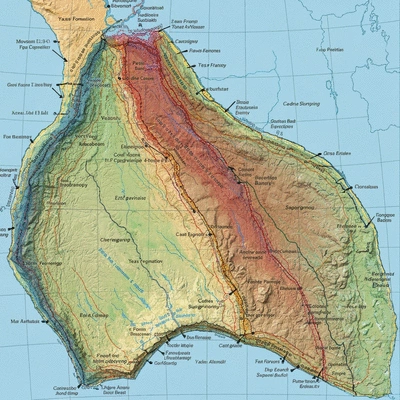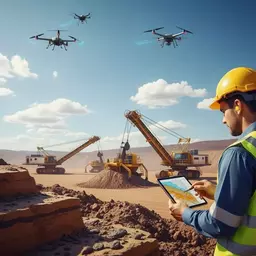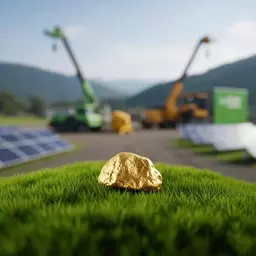Types of Gold Deposits
Orogenic Deposits
Formed during mountain-building; often high-grade.
Turbidite-hosted Deposits
From sedimentary processes; spread over large areas.
Join Madeline Harper's community for exclusive updates on Australian gold mining trends, exploration, and investment opportunities.
Posted on: 2025-10-26
By: Madeline Harper
As the gold mining sector evolves, understanding the geological nuances of the Lachlan Fold Belt becomes crucial for those looking to invest or explore within this rich landscape. What key insights can you take away from this geological marvel? Here are the vital lessons to keep in mind.
The Lachlan Fold Belt’s geological characteristics shape its gold potential. This visual highlights the distinct types of gold deposits and the crucial geological formations that impact exploration efforts.
Formed during mountain-building; often high-grade.
From sedimentary processes; spread over large areas.
Often lead to high-grade gold deposits.
Host turbidite deposits; clues for locating gold.
Indicate potential mineralization.
Prioritizing eco-friendly mining practices.
Big data for informed exploration decisions.
Partnerships respecting local rights & knowledge.
Enhances geological survey accuracy.
Detailed mineral analysis without extensive drilling.
Utilizes satellites/drones for data in hard-to-reach areas.
The Lachlan Fold Belt is not just a geological marvel; it's a hotspot for gold mining in Australia. This region's unique formation and structure contribute significantly to its rich mineral deposits. As a mining enthusiast, I find it fascinating how the intricate geological processes that shaped this area continue to influence exploration and extraction today. This understanding can empower investors, industry professionals, and enthusiasts alike to make informed decisions.
But what exactly makes this region stand out? The Lachlan Fold Belt is characterized by its complex geological history and diverse rock types. Here’s a brief overview of what sets it apart:
These factors together create a unique geological environment where gold deposits can flourish. Understanding them is crucial for anyone looking to explore this dynamic region.
The formation of the Lachlan Fold Belt is the result of complex geological processes that occurred over millions of years. The folded rocks found here are indicative of significant tectonic activity, making it a compelling area for gold exploration. This ongoing geological evolution means that opportunities abound for those willing to invest the time and resources into understanding the landscape.
As a passionate advocate for sustainable mining practices, I believe that understanding these formations not only helps in locating gold but also encourages respectful exploration of this valuable landscape.
When it comes to gold deposits in the Lachlan Fold Belt, two primary types emerge: orogenic and turbidite-hosted. Each type has distinct characteristics and implications for exploration. Here's a quick comparison:
Understanding the nuances between these two types is essential for investors and prospectors alike. It guides their exploration efforts and investment strategies, especially in a region with such rich mining history. This detailed geological insight is crucial for navigating the broader Australian gold mining market.
The geological formations within the Lachlan Fold Belt play a pivotal role in determining the potential for gold mining. Various strata of rock not only contain gold but also influence how and where it can be extracted. Familiarizing ourselves with these formations can greatly enhance our prospecting efforts.
As I delve deeper into the geological intricacies of this region, I’m continually reminded of how each rock layer tells a story. For anyone involved in gold mining or investment, these narratives are not just academic; they are the keys to unlocking the full potential of the Lachlan Fold Belt.
When exploring the Lachlan Fold Belt, consider investing in geological mapping software. This technology can significantly enhance your understanding of the region's complexity and help identify potential gold deposits more efficiently. By utilizing advanced tools, you can gain a competitive edge in your exploration efforts.
The Lachlan Fold Belt is positioned for exciting developments in the gold exploration landscape. As we look ahead, it's essential to recognize emerging trends that could shape the industry over the next few years. The integration of advanced technologies, coupled with sustainable practices, is paving the way for a more efficient and responsible approach to gold mining.
One trend to watch is the increasing emphasis on innovative exploration methods. These methods not only enhance the efficiency of locating new deposits but also minimize the environmental footprint of mining activities. As we delve into these trends, it's crucial for investors and stakeholders to stay informed about the potential opportunities they present.
As the gold market continues to evolve, several key trends are emerging that will influence the future of exploration in the Lachlan Fold Belt:
These trends are not just reshaping the operational strategies of mining companies; they’re also creating a new narrative around gold exploration. By embracing these changes, we can expect a more sustainable and profitable future for the Lachlan Fold Belt. This includes leveraging AI's impact on gold mining to refine exploration and extraction processes.
In the realm of exploration, technology is the game changer. Advanced tools are revolutionizing how we explore and extract gold. Some of the most significant advancements include:
These technologies not only improve the efficiency of mining operations but also help in making informed decisions that can have lasting impacts on the environment and local communities.



 As we gear up for the investment opportunities of 2025, understanding the dynamics of the Australian
As we gear up for the investment opportunities of 2025, understanding the dynamics of the Australian
 In an era where technology meets tradition, the gold mining industry is at the forefront of innovati
In an era where technology meets tradition, the gold mining industry is at the forefront of innovati
 What does the future of gold mining look like, and how can we ensure it is sustainable? As the indus
What does the future of gold mining look like, and how can we ensure it is sustainable? As the indus